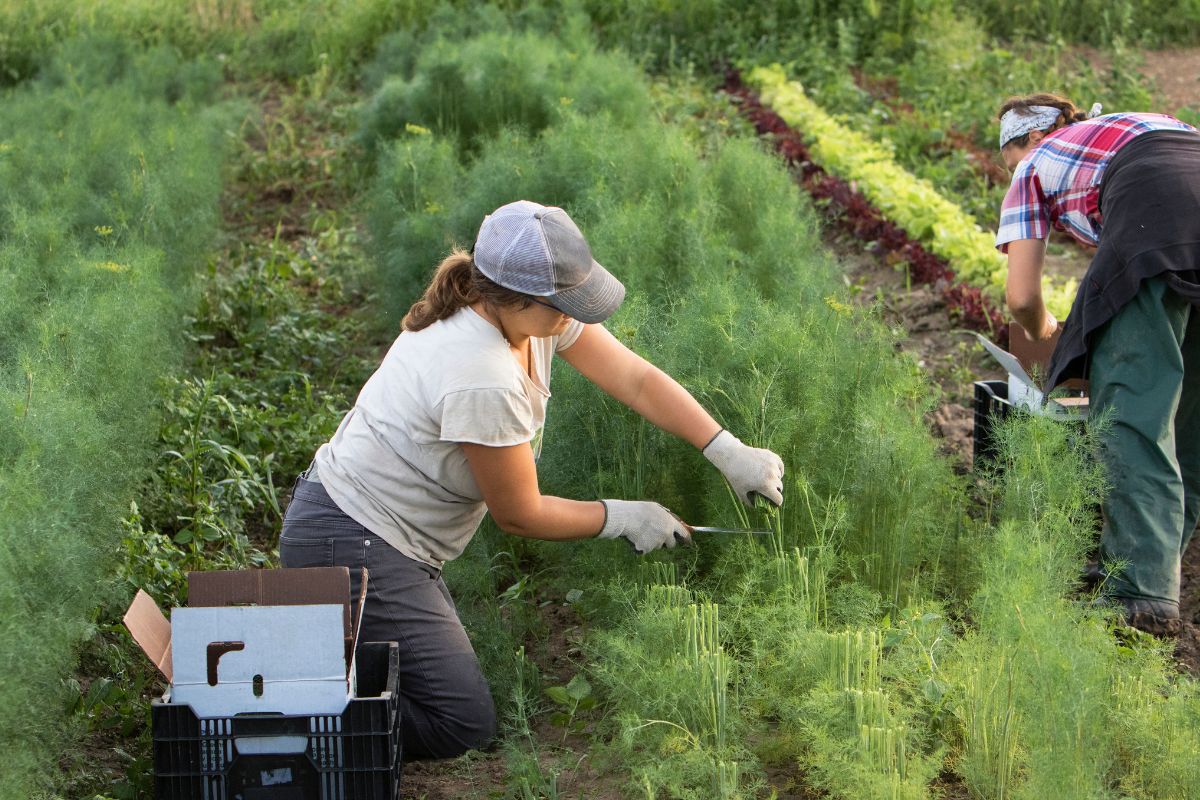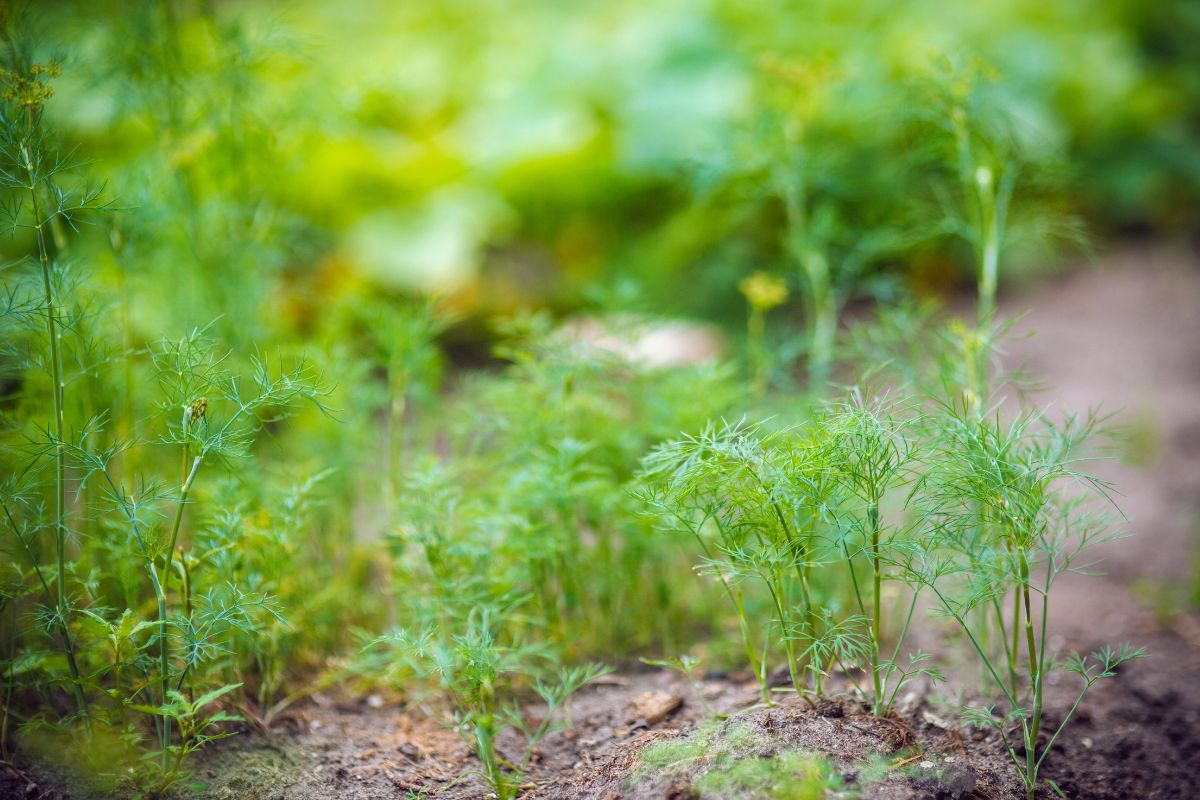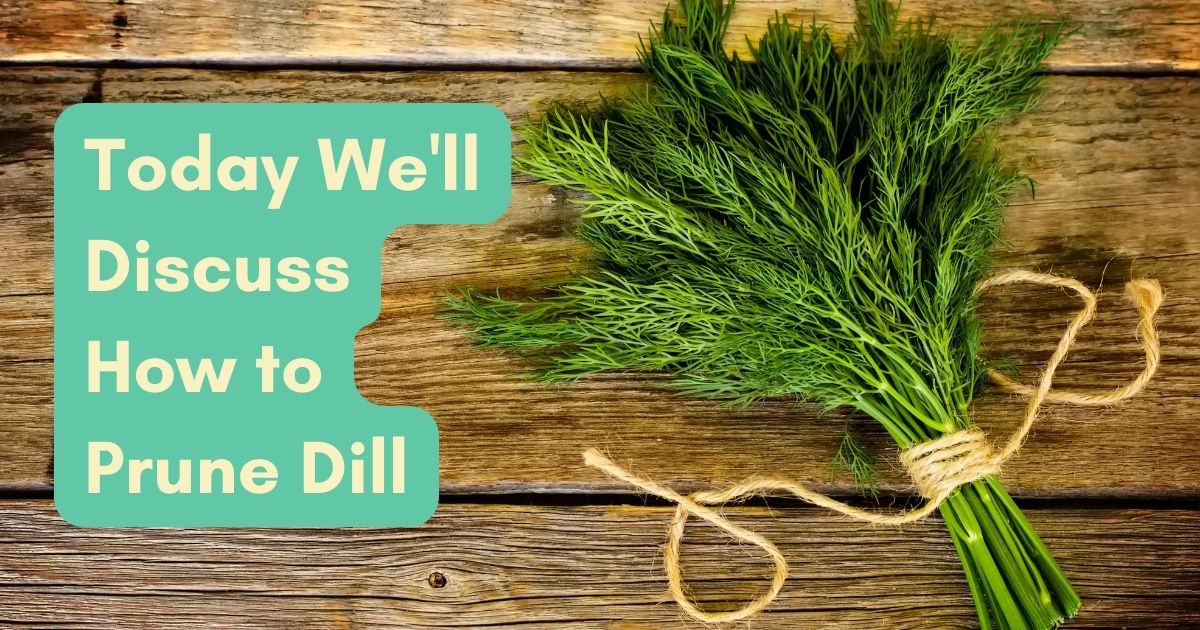Learn how to prune dill like a pro! To keep your dill plants healthy and looking their best, you must know how to prune them properly. Pruning dill will help the plant grow better and produce more herbs. Follow the instructions in this article on how to trim dill and see the results for yourself!
What is Dill?
Dill, also known as Anethum graveolens, is a member of the Apiaceae family, including carrots, celery, and parsley. It is an annual herb that grows to about 2 feet (0.61 meters) tall and has thin, blue-green leaves. Dill flowers are small and yellow, and they bloom in summer. The dill plant is native to the Mediterranean but is now grown worldwide.

What is Dill Used For?
Dill has a long history of use in both culinary and medicinal applications. You can use the dill leaves and seeds to flavor food. You can also use dill leaves fresh or dried and have a mild, anise-like flavor. Dill seeds are a spice with a more intense flavor than their leaves. Dill is commonly used to flavor pickles, but you can also use it in soups, salads, and other dishes.
The dill plant has many health benefits. Dill is a good source of vitamins A and C, iron, and manganese. Dill also contains a volatile oil responsible for its characteristic aroma and flavor. You can find this oil in many perfumes and soaps.
Dill Varieties
The best dill variety to use depends on your preferences. Are you going to cultivate dill in a garden or containers? Are you hoping for it to self-seed, or do you want to replant it every year? Do you intend to use your dill in recipes for canning or cooking? Consider these inquiries before selecting a dill variety to determine which type is most appropriate for your requirements.
Bouquet dill: This type produces a lot of seeds and grows pretty tall. This makes it an excellent option for in-garden planting and promoting the growth of your dill plants the following year. You can also use the dill seeds in cooking. This dill is also our favorite for producing pickles since it makes a lot of seed heads that are ideal for canning.
Fernleaf: This variety is small and works nicely in containers.
Mammoth Dill: This is one of the best culinary dill kinds and a superb choice for pickling dishes. It pairs well with fish, salads, and soups. Mammoth dill needs a lot of room in your garden because it may grow up to 5 feet (1.5 meters) tall.
Dukat dill: It’s a small type of dill that grows nicely in containers. This variety of dill is better for adding to salads since it has a lighter shade of green than other dill weeds.
Vierling: Unlike other dill varieties, the Vierling takes a little longer to bolt. Vierling is a great option if you want a continuous harvest all summer long.
Dill is a great option if you are looking for a new herb to try. Its unique flavor will enhance the taste of many of your favorite dishes. Give it a try today!
Should Dill be Pruned?
Pruning the dill plant is generally not necessary. However, if you want to control the size of the plant, you can trim the dill back after it blooms. Be sure to leave at least a few inches of stem so the plant can continue to grow.
It would help if you allowed the plant to flower to grow dill for its seeds. Once the flowers turn brown, cut the stalk and shake it over a bowl.
Types of Equipment for Pruning Dill
Pruning tools exist in a variety of sizes, forms, and designs. They will mostly fit in your hand. You may swing them, push them, pull them, bend and twist them. There are many different tools that gardeners can and do use.
However, tools are not magical. When you don’t know how to use them, they start to act like magic.
When pruning dill, there are three essential tools to use:
Pruning Saws
For more accurate cutting, pruning saws are useful. A clean, smooth stub is all that is left after a sharp blade cuts off the branch. The saw has a handle on one end and a sharp point on the other. It somewhat resembles a little pruning knife. A pruning saw needs to be razor-sharp to perform well.
Loppers
They have a longer reach, better cutting force, and longer than large pruning saws. Sharp-cutting blades and handles are features of loppers and loppers.
By Hand
Use your hands to move branches aside, trim small branches, and dig in the compost pile. Removing branches that are challenging to see performs better than a pruning saw or loppers.
How to Prune Dill
It will help if you prune the dill once it is a few weeks old. You should feel a slight roughness in the leaves if you lightly rub one between your fingertips. The plant is going to seed because of this roughness. Remove flower buds from herbs as soon as they develop to promote more leaves and fewer blooms.
Below are three ways how to trim the dill plant:
- Dill Cutting and Shaping
To promote bushier growth, trim the tops of the leaves. Pick leaves close to the plant’s top to cut them off. The plant will be encouraged to grow downward rather than upward. Dill plants have numerous small stems that branch out of the main branch, each of which has tiny fingers that resemble ferns. A leaf is attached to each of these small stems.
Please take a few little branches here and there and use them to season your food. You can easily use your fingers to prune a few stalks of dill if you only need a little for dinner. It would help if you didn’t have any trouble pulling them off in this method because they are soft enough.
As long as you take care to avoid pulling the plant out of the ground, this won’t harm it.
Harvest or prune continuously throughout the year. Depending on the time of year, some plants don’t want you to prune them. On the other hand, you can prune dill or harvest it whenever it is green and expanding.
But before you aggressively prune it, you might want to let it mature first. The growth process typically takes eight weeks from seed to fully grown plant.
When pruning, leave at least 2/3 of the plant. Avoid removing more than one-third of the plant while trimming or harvesting. You want to leave the plant with a sufficient number of leaves so that it can still get the sunlight it needs. Your plant could wither if you make too many cuts.
Cut off the blossoms to prevent the plant from setting seed. Pinching off flowers as they appear is a smart move during the growth season. That promotes the plant’s growth. The plant will typically disappear if you let it go to seed. Pinch the stem where the branch of the flower connects to another branch. Cut it off above the joint.
Dill plants have small, yellow flowers. Near the plant’s top, they gather in rings. Either harvest the seeds or allow the plant to self-seed after the growing season. Reseeding lets the plant shed its seeds to ensure it returns the following year.
- Use and Preservation of Fresh Dill
As early as possible, put your dill to use. Use the dill you have as soon as possible. During this time, it will be at its most flavorful. Cut it just before using it in your cuisine because of this.
Instead of using a knife while chopping Dill in the kitchen, try using scissors. It will add more taste.
Keep dill in the fridge in a jar. Fill the bottom of a mason jar with water to a depth of 1 to 2 inches (2.5 to 5.1 centimeters). Once you have clipped off the bottoms of the stems, submerge the dill stem-side down. If at all feasible, put a lid on it and place it in the refrigerator.
- Use a plastic bag and a rubber band if a lid will not fit over the jar.
- You can keep the herbs for up to two weeks.
- Dill Harvesting Towards the End of the Season
The day before you harvest the dill, water it. Wait until the plant has flowers but hasn’t bloomed to pick complete dill plants. You can clean the plant of dirt before being cut by spraying it the day before harvest.
On the day of harvest, you don’t want water on the plant because that could cause decay.
At the end of the growing season, cut Dill to the ground. Since dill is an annual, you can cut it off at the stem’s base to end the growing season. You should chop off the plant using pruning shears.
To ensure the plant receives moisture:
- Trim the dill in the morning. When you cut the plant, you want it to be well-hydrated.
- Place the stems in a glass of water like you would flowers if you can’t trim them in the morning.
- Give them two hours in the water.
To dry, hang the dill—wrap rubber bands around the little bundles of dill to keep them together. Select a location that is warm, dark, and low in humidity. To dry, hang the bunches up. Don’t bundle the items too tightly. Loose bundles encourage airflow, which inhibits the growth of mold.
Please give them a couple of weeks. You can prepare them when the leaves are dry enough to crumble in your palm. You can preserve dill intact or crushed in an airtight container. After a week, check the jar for moisture. Take the dill out of the container and spread it to dry if you spot any.
You can save the seeds by placing the plants in a bag and hanging them upside down. First, keep an eye out for the flowers, then the seeds. Once the seeds have popped up, trim the stalk 4 inches (10 centimeters) below the flower. Please don’t wait for them to begin falling off the plant.
Put the plants in the bag and hang them. You will fill the bags with the seeds as they fall.

How Tall Does Dill Grow?
Dill is a herb that can grow quite tall, reaching up to 6 feet (1.82 meters). It has long, slender leaves that are green in color and have a somewhat grassy texture. The dill plant height ranges between 2 and 4 feet (0.61 and 1.22 meters).
Dill has flat heads of vibrant yellow flowers with intricate buds and finely cut leaves. Its soft, feathery texture creates a wonderful backdrop for flowers or veggies. Plants have the ability to self-seed. When the seeds are ready, they begin to disperse, so you must gather and dry them immediately to be used in the winter.
Does Dill Grow Back Every Year?
Dill is a common herb with a distinctive growing method. You could continue harvesting this plant without replacing it because of its advantageous leaves.
So, if you’re planting dill for the first time, you might be curious about its yearly growth.
Does dill regrowth occur annually? Most of the time, dill will regrow if permitted to grow naturally. Dill seeds are highly resilient and can persist for a long time. As a result, after the parent plant dies, the seeds will sprout into a new plant, given the ideal conditions for growth.
How to Trim Dill for Growth
When the plant is a few months old, trim the leaves closest to the plant’s top with a pair of clean garden shears. Snip the leaves where they meet the stem and use them in dishes all season long. They will produce a lot of leaves further down the stalk if you prune them from the top of the plant.
The Benefits of Trimming Dill
Dill is an annual plant, but with the appropriate growth circumstances, it will self-seed and come back year after year. Dill seed is also easily saved each year for later planting. You can prune the dill plant to reduce its seed production and prevent it from outgrowing its container.
Pruning dill will keep the plant clean and encourage lateral growth, making it bushier. This is ideal if you want a bigger crop of dill to use in pickling, marinades, drying, and other recipes.
A gardener may need to stake dill plants if left to grow unpruned because they can develop at 3 feet (0.91 meters) and become top-heavy. Dill doesn’t require staking because pruning keeps the plant compact and short.
Like most gardeners, you’re always looking for ways to get the most out of your plants. And if you’re growing dill, you may wonder if trimming the plant will promote new growth. The answer is yes! Regular pruning of dill will encourage the plant to produce more leaves, which can be used fresh or dried in many culinary dishes.
In addition to promoting new growth, trimming dill helps keep the plant tidy and prevents it from going to seed. When left untrimmed, dill can become leggy and produce fewer leaves. So if you’re looking for a bountiful harvest of dill, ensure you give your plants a regular haircut!
When to Prune Dill
Dill is a fast-growing plant that will quickly become overcrowded if not pruned. It’s best to prune dill when it is 6 to 8 inches (15.24 to 20.32 centimeters) tall. Pinch off the tips of the main stem and any side stems that are longer than 6 inches (15.24 centimeters). This will encourage the plant to branch out and become bushier.
Early harvesting of a few stems or leaves of dill is possible, but you should postpone heavy trimming until the plant has reached maturity. The plant will mature and be ready for extensive, severe trimming eight weeks after you plant the seeds. Wouldn’t it be nice if all plants grew as quickly?
To give the plant a uniform height and attractive shape, trim the tops off the longest stems and even the remaining ones. When pruning, don’t remove more than one-third of the plant; otherwise, the plant might not survive.
Unless you want the bushy herbs to reseed for the following year or if you’re going to collect the seeds, prune before the plant blooms.
FAQs
What is the Lifespan of a Dill Plant?
Dill plants live as long as it takes them to bolt and start producing seeds. This procedure typically occurs during one growing season in most climates.
Irrespective of whether you plan to grow dill again the following year, we advise letting plants bolt and blossom. Dill flowers are very attractive to pollinators. Additionally, dill has the advantage of self-seeding for the next season if you decide to grow it again.
Can I Try to Grow Dill Inside?
Yes! Pick a dwarf kind of dill or another miniature variety, such as Fernleaf dill or Dukat dill. If at all feasible, pick a pot at least a foot deep. Put the pot in a sunny spot and give it a few weekly waterings.
You can start collecting the dill leaves if there are at least four sets of genuine leaves. Keep your dill compact and bushy by trimming the top of the plant and removing any buds before they can flower to prevent it from outgrowing its indoor container.
How Can I Give My Dill a Bushy Trim?
Cut off the tops of the plant to develop a dill plant that is bushier than usual. When you frequently remove the top of branches and leaves, new growth usually shoots up from the bottom and out from the sides producing a bushy-like plant.
How Should I Trim Dill to Prevent Damage?
Cutting off stems and leaves where they emerge from the main branch is the easiest technique to trim dill without harming or killing the plant. To prevent accidental injury or stunted growth, always use the sharpest scissors or snippers you can find.
What Can I Grow With Dill?
Dill is a wonderful addition to any garden because it gets along well with other plants. Your dill plant’s flowers will draw helpful insects and pollinators, which will support the growth of other plants.
Dill is a fantastic partner for all these plants since it encourages predatory insects to fend against pests that wreak havoc on corn, cucumbers, asparagus, basil, and lettuce.
Dill’s pungent flavor helps ward off pests like cabbage loopers and cabbage worms that could harm your brassica plants. As a result, you should plant dill close to kohlrabi, cabbage, Brussels sprouts, broccoli, kale, and collards.
Dill grows well with garlic and onions because their aroma deters insects that would attack dill plants. Another excellent plant to consider growing with dill is celery.

Our Parting Words
As we say goodbye, we want to leave you with a few parting words of wisdom. First and foremost, don’t forget to trim your dill! Regular pruning will encourage new growth and prevent the plant from going to seed.
Secondly, if you live in an area with a short growing season, dig up the roots and store them indoors over winter. And lastly, dill is a versatile herb you can use in many culinary dishes. So get creative and have fun experimenting with this delicious herb!
